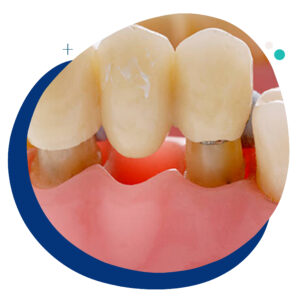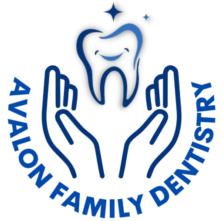Fixed Dental Bridges
Fixed Dental Bridges are used as a means of dental restoration to replace missing teeth. The bridge helps patients to regain the ability to chew, bite, and speak normally by “bridging” the gap left by missing teeth, hence the name “bridge.”
They are made up of a false tooth (also known as a pontic) suspended between two or more crowns placed over the teeth on either side of the gap. The artificial tooth is made specifically to match your natural teeth’ size, color, and shape, giving it a natural-looking appearance.

The Process
The following steps are typically involved in getting a dental bridge:
- Initial Consultation:
Patients will discuss their options for replacing missing teeth during their initial appointment with the dentist. A decision will be made on whether a dental bridge is a suitable choice according to your dental health. To decide where to place your bridge, your dentist will also examine your mouth and take any necessary x-rays or impressions.
- Preparation of Supporting Teeth:
The dentist will remove any decay and reshape the teeth on either side of the gap to make room for the crowns.
- Taking Impressions:
To design a bridge that perfectly fits your mouth, impressions of your teeth will be taken.
- Fabrication of the Bridge:
The bridge is made in a dental lab using the impressions that were taken. Normally, this procedure takes between one and two weeks. A temporary bridge may be erected if necessary while you wait for your permanent bridge to be constructed.
- Permanent Bridge Placement:
During your second appointment, dental cement will be used to attach the permanent bridge to your teeth. To ensure that the bridge fits correctly and that you can bite and chew comfortably, your dentist will examine your bite and make any necessary adjustments.
- Follow-up Visit:
An appointment will be set up to evaluate your bridge’s comfort and fit and make any necessary modifications.
Types of Dental Bridges
- Traditional Bridges:
For this type of bridge, two crowns are affixed to healthy teeth or dental implants on either side of the gap, and one or more artificial teeth, or pontics, are attached to the crowns.
- The Cantilever Bridge:
When there are healthy teeth on only one side of the gap left by a missing tooth, a cantilever bridge is used. One end of the pontic extends into the space, and the other end is connected to a crown that is affixed to the healthy tooth.
- Maryland Bonded Bridges:
These bridges attach to the backs of the surrounding healthy teeth on either side with metal or resin wings on either side of a metal or porcelain framework that supports the pontic.
Can Dental Bridges Damage Surrounding Teeth?
The surrounding teeth are typically not harmed by dental bridges. However, if the supporting teeth are not properly prepared or if the bridge does not fit correctly, it may result in issues like tooth decay, gum disease, or bite issues that may eventually affect the neighboring teeth.
To reduce the chance of damaging neighboring teeth, Avalon Family Dentistry will take the necessary precautions and guarantee proper placement and fit of the bridge. Additionally, regular dental cleanings and examinations can help to monitor the condition of the neighboring teeth and identify any potential issues.
How Do I Care For My Dental Bridge?
Maintaining the longevity and health of your restoration requires proper care for your dental bridge. Your bridge will last for many years with proper maintenance, and your neighboring teeth and gums will remain in good condition.
Following are some pointers for maintaining your dental bridge:
- Brush and Floss Frequently:
Use fluoride toothpaste and brush your teeth twice a day for a couple of minutes each. Brushing is essential to remove plaque and food particles from the bridge and the teeth. Use waxed floss or an interdental brush to clean beneath and around the bridge each day to avoid plaque accumulation and tooth decay.
- Regular Mouthwash:
Rinsing with an antiseptic mouthwash can help to stop bacteria and improve breath.
- Avoid Eating Hard Foods:
Your dental bridge might be damaged by hard items like ice, candy, and popcorn. Avoid biting or chewing on hard items because doing so can harm your bridge by causing chips, cracks, or other problems.
- Routinely Visit the Dentist:
Maintaining the health of your dental bridge and the surrounding teeth requires routine dental exams and cleanings. Your dentist will keep an eye on the alignment and fit of your bridge and make any required modifications to ensure that it continues to perform as intended.
- Wear a Night Guard:
A night guard might help prevent damage to your dental bridge if you clench or grind your teeth at night.
- Avoid Using Your Teeth as Tools:
Opening packages with your teeth, biting your fingernails, or chewing on pens or pencils can put too much pressure on your dental bridge and the teeth around it.
- Don’t Neglect Your Oral Hygiene:
If you don’t brush or floss your teeth regularly, this can cause plaque to build up, gum disease to form, and tooth decay, which can harm the health and durability of your dental bridge.



